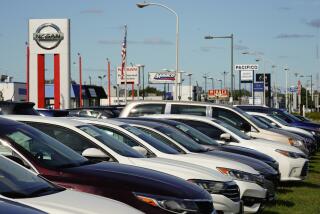Cash-hungry lenders paying more to savers
- Share via
Your bank wants your money and may be willing to pay a decent rate for it.
After falling for most of the last year, average rates on certificates of deposit have been picking up since the end of April. Some banks -- including brand-name institutions with locations in Southern California -- are offering more than 4% on a one-year CD.
Nationwide, the average annual yield on one-year CDs fell to 1.92% in April, down from 3.75% in August 2007.
“During the past 12 months, savers really took it on the chin,” said Greg McBride at Bankrate.com, noting that inflation also worsened during that time.
But since then, the average yield on a one-year CD has rebounded to 2.38%. That’s still not great, but if you shop around you can get more.
Mortgage lender Countrywide, now a division of Bank of America Corp., is promoting a seven-month CD paying a 4.10% annual rate. Online lender E-Loan is offering 4.17% for one-year deposits. Santa Monica-based First Federal Bank is offering a nine-month CD paying 4.23%, which will reset upward at three-month intervals if Treasury rates rise.
At Washington Mutual, you can get 4.25% on a 13-month certificate. Even Wells Fargo Corp., which is not known for high rates, is offering a 19-month CD that pays 3.35% -- and a bit more than that for some good customers.
If you’re not satisfied with the rate your bank is offering, you might want to ask for something better.
“Consumers can really take advantage of this,” said First Federal Chief Executive Babette E. Heimbuch. “Go into your bank and say, ‘What can you do for me?’ Don’t be passive.”
Reasons for the higher rates include the continuing credit crunch, fallout from the failure last month of IndyMac Bank and a move by Bank of America, the country’s biggest bank in terms of deposits, to gain market share.
Bank of America started offering 4% on some deposits in July, spokeswoman Colleen Haggerty said.
“In Los Angeles and several key markets, we launched a long-term deposit growth strategy,” she said. “Isn’t that good for consumers?”
Meanwhile, with the credit crunch showing signs of re- intensifying in recent weeks, banks may view higher CD rates as their best option.
“For banks that want to get their hands on cash, it’s a lot easier to pay up on consumer deposits than to tap the credit markets,” McBride said.
At the same time, IndyMac’s July 11 failure has unnerved some savers, leading them to demand higher rates to compensate for the risk they now associate with banks.
But if you deposit no more than $100,000 at one bank, you don’t need to be concerned that it might fail, McBride said. That’s because federal deposit insurance covers that amount.
There are ways to structure deposits over $100,000 so they are fully insured, but some IndyMac savers who did so have complained of delays in getting access to their money after the bank failed. That’s rarely an issue for holdings under $100,000.
--
More to Read
Inside the business of entertainment
The Wide Shot brings you news, analysis and insights on everything from streaming wars to production — and what it all means for the future.
You may occasionally receive promotional content from the Los Angeles Times.










